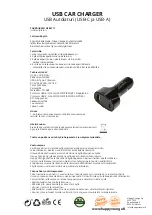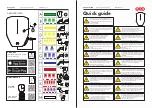
Engine temperature while plowing
When driving with a plow, your
engine may run at a higher
temperature than normal because
the attached snowplow blade will
restrict airflow to the radiator.
If you are driving more than 24 km (15 miles) at temperatures above
freezing, angle the plow blade either full left or full right to provide
maximum airflow to the radiator.
If you are driving less than 24 km (15 miles) at speeds up to 64 km/h
(40 mph) in cold weather, you will not need to worry about blade
position to provide maximum airflow.
4WD operation while plowing
•
Shift transfer case to 4x4 LOW (4WD Low) when plowing in small
areas at speeds below 8 km/h (5 mph).
•
Shift transfer case to 4x4 HIGH (4WD High) when plowing larger
areas or light snow at higher speeds. Do not exceed 24 km/h
(15 mph).
•
Do not shift the transmission from a forward gear to R (Reverse) until
the engine is at idle and the wheels are stopped.
•
If the vehicle is stuck, shift the transmission in a steady motion
between forward and reverse gears. Do not rock the vehicle for more
than a few minutes. The transmission and tires may be damaged or
the engine can overheat.
It is the owner’s responsibility to avoid engine overheating which
can cause damage.
Do not spin the wheels at over 35 mph (55 km/h). The tires may
fail and injure a passenger or bystander.
H
C
Driving
166
Summary of Contents for 2001 F350
Page 100: ...Regular Cab and 4 door CrewCab 4 door Super Cab if equipped Seating and safety restraints 100...
Page 187: ...Front 4x2 F450 550 Front driver side 4x4 Roadside emergencies 187...
Page 188: ...Front passenger side 4x4 Rear Roadside emergencies 188...
Page 285: ...285...
Page 286: ...286...
















































